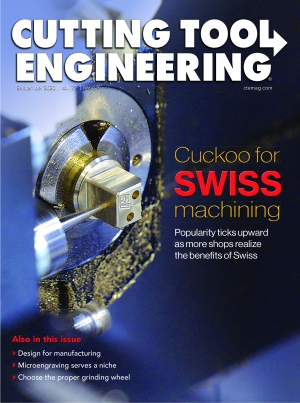Dear Doc: We struggle with grinding burn. There’s talk of putting in a coolant refrigeration system. Will that fix the problem?
 The Doc replies: Probably not. There are good reasons to install a refrigeration system, but eliminating grinding burn isn’t one.
The Doc replies: Probably not. There are good reasons to install a refrigeration system, but eliminating grinding burn isn’t one.
Let’s assume you’re talking about rehardening burn, in which a workpiece becomes hotter than approximately 750° C (1,382° F), resulting in phase change in the steel, or “white layer.” A coolant at 20° C (68° F) sucks out only slightly more heat than coolant at 30° C (86° F) because the rate of convective heat transfer depends on the temperature differential between the coolant and the hot workpiece. Coolant at 20° C sucks heat out of a 750° C workpiece only 1.4% faster than coolant at 30° C [(750-20) / (750-30) = 1.014 = 1.4%]. In other words, if you burn with hot coolant, you’ll almost certainly burn with cold coolant.
The exception is if you experience burnout in creep-feed grinding. Here, you get large-scale coolant vaporization and lose almost all your cooling effect, causing a surge in grinding power and sudden, catastrophic burn. But this is very rare. In the vast majority of cases, you should fix your burn problem some other way, likely by dressing sharper (and using a smaller-grit wheel if surface finish becomes too rough), improving cooling velocity and aim (especially in creep-feed operations) or changing machine parameters.
Dear Doc: When we arrive on Monday mornings, we cycle machines without workpieces to warm up things. Some operators do it with coolant on, and some do it with coolant off. What’s your take?
The Doc replies: I’m a fan of doing it with coolant on. Your grinding machine is a giant heat generation system, and all that heat eventually has to go somewhere. When you cycle without coolant, almost all the heat ends up in the metal of the grinding machine, increasing the temperature. And hot things like to expand.
Your workpiece base ultimately connects to your grinding wheel through a series of contacts: toolholder, headstock, machine base, columns, bearing assembly, spindle and wheel. All those parts expand at different rates, causing a growing, twisting and contorting grinding machine. That really isn’t an issue as long as the growing, twisting and contorting reach a steady-state position.
Let’s throw out some ballpark estimates. Say there’s 1 m (3.3') of steel “linkage stuff” connecting your workpiece and wheel. During your Monday morning dry cycle, if all that steel heats up by a modest 2° C, the meter will expand by 0.026 mm (0.001") (dimensional increase = original dimension × coefficient of thermal expansion for steel × temperature increase = 1,000 mm × 13×10-6 mm/mm/°C× 2° C = 0.026 mm).
So far, no problem. You dress your wheel, grind a part, find the size, make adjustments and start your long batch run. But now you’re running with coolant on, which starts sucking out heat from everywhere. The temperature increase is no longer 2° C but 1° C. The linkage stuff gradually will shrink by 0.013 mm (0.0005"), bringing your wheel closer to your workpiece. Taken on diameter, that’s a 0.026 mm decrease. Can you live with that? It depends on your tolerances.
This is all a gross simplification, but you get the idea. So, I say cycle with coolant on. It’s not that a colder machine is any better. It’s that we want the temperature to stay more constant. In fact, that’s a main discussion point when speaking with my customers about whether they need a refrigeration system. The question is not whether they need lower temperatures — it’s whether they need more consistent temperatures.
Related Glossary Terms
- coolant
coolant
Fluid that reduces temperature buildup at the tool/workpiece interface during machining. Normally takes the form of a liquid such as soluble or chemical mixtures (semisynthetic, synthetic) but can be pressurized air or other gas. Because of water’s ability to absorb great quantities of heat, it is widely used as a coolant and vehicle for various cutting compounds, with the water-to-compound ratio varying with the machining task. See cutting fluid; semisynthetic cutting fluid; soluble-oil cutting fluid; synthetic cutting fluid.
- creep-feed grinding
creep-feed grinding
Grinding operation in which the grinding wheel is slowly fed into the workpiece at sufficient depth of cut to accomplish in one pass what otherwise would require repeated passes. See grinding.
- dressing
dressing
Removal of undesirable materials from “loaded” grinding wheels using a single- or multi-point diamond or other tool. The process also exposes unused, sharp abrasive points. See loading; truing.
- grinding
grinding
Machining operation in which material is removed from the workpiece by a powered abrasive wheel, stone, belt, paste, sheet, compound, slurry, etc. Takes various forms: surface grinding (creates flat and/or squared surfaces); cylindrical grinding (for external cylindrical and tapered shapes, fillets, undercuts, etc.); centerless grinding; chamfering; thread and form grinding; tool and cutter grinding; offhand grinding; lapping and polishing (grinding with extremely fine grits to create ultrasmooth surfaces); honing; and disc grinding.
- grinding machine
grinding machine
Powers a grinding wheel or other abrasive tool for the purpose of removing metal and finishing workpieces to close tolerances. Provides smooth, square, parallel and accurate workpiece surfaces. When ultrasmooth surfaces and finishes on the order of microns are required, lapping and honing machines (precision grinders that run abrasives with extremely fine, uniform grits) are used. In its “finishing” role, the grinder is perhaps the most widely used machine tool. Various styles are available: bench and pedestal grinders for sharpening lathe bits and drills; surface grinders for producing square, parallel, smooth and accurate parts; cylindrical and centerless grinders; center-hole grinders; form grinders; facemill and endmill grinders; gear-cutting grinders; jig grinders; abrasive belt (backstand, swing-frame, belt-roll) grinders; tool and cutter grinders for sharpening and resharpening cutting tools; carbide grinders; hand-held die grinders; and abrasive cutoff saws.
- grinding wheel
grinding wheel
Wheel formed from abrasive material mixed in a suitable matrix. Takes a variety of shapes but falls into two basic categories: one that cuts on its periphery, as in reciprocating grinding, and one that cuts on its side or face, as in tool and cutter grinding.
- toolholder
toolholder
Secures a cutting tool during a machining operation. Basic types include block, cartridge, chuck, collet, fixed, modular, quick-change and rotating.








